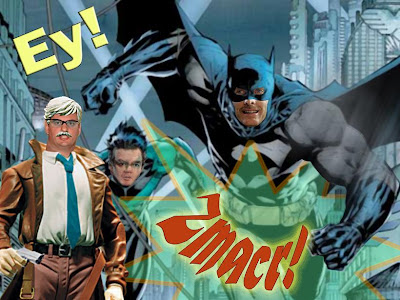Commissioner Cordon and the dynamic duo, in the hunt of the Prowler of La Matanza.
A cruel new threat is casted over the gotham city of Conceitopolis. Around its streets, some of them half-lighted (certainly not those of the fanciest districts where the public space has been privatized), some cut across by the craters of unfinished pothole repairs or blocked by road work fences with no light signs at all, the sinister shadow of a new public enemy wanders. It's the gloomy Prowler of La Matanza.
Guided by the Commissioner Burt Zak Cordon, the superheros of Good recharge their powers to fight this scourge.
It would be useful if the noble commissioner provided clues to rapidly recognize the wicked. That would let the people of Conceitopolis take precautions and, eventually, alert the forces of the Law with no delay. The commissioner has to know, for sure, some few more things about the Prowler, besides the fact that he or she comes from La Matanza: perhaps he can reveal info about the Prowler's ethnic roots, or about the pigmentation of his or her skin, the aspect of his or her dress and shoes, his or her jergon and gestures, his or her conduct.
Some decades ago, the ruling generals used to advice the population about the behavior and appearance of the arch enemies of those times. Should the commissioner attempt a description of the like, it would be helpful to better know him (not as much the Prowler of La Matanza as the Commissioner himself).
Guided by the Commissioner Burt Zak Cordon, the superheros of Good recharge their powers to fight this scourge.
It would be useful if the noble commissioner provided clues to rapidly recognize the wicked. That would let the people of Conceitopolis take precautions and, eventually, alert the forces of the Law with no delay. The commissioner has to know, for sure, some few more things about the Prowler, besides the fact that he or she comes from La Matanza: perhaps he can reveal info about the Prowler's ethnic roots, or about the pigmentation of his or her skin, the aspect of his or her dress and shoes, his or her jergon and gestures, his or her conduct.
Some decades ago, the ruling generals used to advice the population about the behavior and appearance of the arch enemies of those times. Should the commissioner attempt a description of the like, it would be helpful to better know him (not as much the Prowler of La Matanza as the Commissioner himself).
_________________________________________________________
Now let us have a look at the facts:
The new chief of the new police of the Autonomous City of Buenos Aires (CABA), Eugenio Burzaco, wants his troops to be legally empowered to arrest people who "prowl" at town. He insisted that adding the legal figure of "prowling" to the Capital City's violation code would be highly convenient, and justified his initiative by saying: "It's a very useful tool because if somebody living in La Matanza is in the Capital City but cannot explain what he or she is doing there, that figure will be enough justification to arrest that person" ("La Nación", 01-23-2009).
Out of the 24 municipalities sorrounding the CABA, which together form the giant urban conglomerate know as "Greater Buenos Aires" (GBA), La Matanza is the most largely populated one. According to the census of 2001, it had 1,255,000 inhabitants, which will certainly overpass 1.4 million the coming year, when the next census will take place. Only the CABA itself and 5 Argentine provinces else have a larger number of inhabitants (including among the five the Buenos Aires Province, to which La Matanza belongs).
Let's next visit some of the differences between La Matanza and the CABA:
1) Most of La Matanza's inhabitants are young people: in 2001, 54% of its population was under 30; the same age cluster made only 40% of total CABA's population.
2) The segment with unsatisfied basic needs reached 20% of La Matanza's and just 7.8% of the CABA's total population, always according to the 2001 census.
3) A recent study by private researchers ("La Nación", 06-18-2009) threw 36.8% poverty and 11.8% indigence indexes for GBA, which at CABA were much lower: 13.9% and 3.1% respectively. But in the farthest urban belt, in which a vast area of La Matanza falls, poverty climbed up to 49.1% and indigence up to 17.2%. Such figures difer from those reported by INDEC, the Federal Government's statitics bureau, for whom poverty was 17.8% and indigence 4.7% at GBA in 2008, 2nd Half. But even picking these benevolent official figures, the gap between GBA and CABA is still nothing but dramatic.
4) Scarcely 39% of La Matanza's homes had in-house water supply and sewerage facilities in 2001, while at the CABA almost every home, 99%, did enjoy such privileged condition.
5) Again according to the 2001 census, no more than 42% of La Matanza's inhabitantes were protected by some kind of health insurance system, while the same figure was 74% at the CABA.
It can be concluded, then, that the Chief Police Officer expects the potential agressors to be clearly differentiated from the average inhabitant of the Capital City: they will most likely be young, maybe poor, and will probably turn up in sub-optimal hygien and health conditions. A good frist step to start pointing to the prawlers and mobilizing City forces against them.
Back to The Shuttle's website.



No hay comentarios:
Publicar un comentario